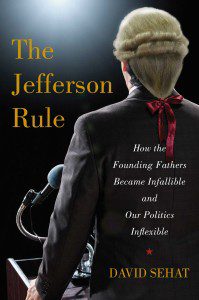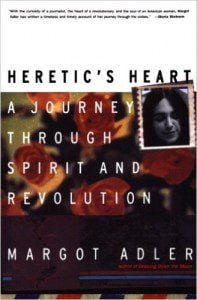This past Tuesday was Election Day. But overshadowing any voting this week is the countdown to Election Day 2016, when the ballot will include the candidates seeking to become the 45th President of the United States. So as our nation increasingly turns its attention to November 8, 2016, I would like to  explore some of the roots of the partisan divide in our county using The Jefferson Rule: How the Founding Fathers Became Infallible and Our Politics Inflexible by David Sehat, an Associate Professor of History at Georgia State University.
explore some of the roots of the partisan divide in our county using The Jefferson Rule: How the Founding Fathers Became Infallible and Our Politics Inflexible by David Sehat, an Associate Professor of History at Georgia State University.
As we look to history for lessons that might inform our democracy today, one of the biggest takeaways from Sehat’s book is a reminder that from the beginning, the founders of this nation were not unified in their visions, hopes, and dreams for our county. So we should be wary of anyone who conflates the founders together with claims about “The founders all say this or that.” The founders often disagreed profoundly, and many of those tensions remain with us today (1).
But before we plunge fully into the 18th century, allow me to make one more overall point. I was raised in a theologically- and politically-conservative context, which taught me to believe in a perfect past from which we have fallen. Perhaps you have heard similar stories. In my childhood, this perfect past was embodied theologically in the Garden of Eden, and politically in a rose-colored view of our Founding Fathers and founding documents. I was taught that we should struggle to return ourselves and our society to be in alignment with this allegedly perfect past — but that regardless, in the long run, God would guarantee a perfect future for those who are righteous.
Today, I have come to a different understanding of the past, present, and future. Accordingly, three of my personal maxims are that:
- There was no perfect past to which we can return; however the stories of exemplary lives and communities in the past (such as the founders of this country) can inspire us today.
- There is no single, perfect way for every individual or community to be in the present, which means that I am a pluralist (there is more than one legitimate way), but not a relativist (who believes that every possibility is equally worthy of our time and attention).
- This is no guarantee of a perfect future, but we can nevertheless choose love, compassion, and forgiveness as ways of increasing our chances of creating a hopeful future.
So even as we learn from history, we must also consider new possibilities that were not even conceivable when our nation was founded more than two centuries ago.
Turning, then, historically to the founders of this county, much of what united them was not rallying together for a shared philosophy of government, but rallying against Great Britain (1-2). And when that common enemy was defeated, there was infighting over how best to unite the original thirteen colonies into The United States of America. For instance, when General George Washington became President Washington (1789 – 1797), he found that the cabinet members within his administration were significantly harder to keep unified than the soldiers had been when he was Commander-in-Chief of the Continental Army.
Alexander Hamilton, the first Treasury Secretary, was a vocal advocate for a strong national government. Conversely, Thomas Jefferson (the first Secretary of State) was equally vocal for a weak national government. Moreover, Jefferson — the famed author of the Declaration of Independence — did not support the writing of the U.S. Constitution; he would have preferred to instead continue living under the Articles of Confederation with a few amendments added, and was in Paris during the entire Constitutional Convention (5).
And Jefferson wasn’t the only Constitutional detractor among the founders: “Edmund Randolph — one of three people who had stayed through the entire Constitutional Conversation and then declined to sign the document — became attorney general, the chief law enforcement officer of the new government” (6). Suffice it to say that the “tranquil deliberations and voluntary consent” that President Washington anticipated from the leaders of the new government turned into a much more combative reality.
And in ways that parallel today’s legal arguments about how the Constitution should be interpreted, major controversies arose from the beginning. For instance, on the question of whether forming a national bank was constitutional, Jefferson, Madison, and other founders who favored a smaller, weaker national government emphasized the state’s rights perspective of the Tenth Amendment: “The powers not delegated to the United States by the Constitution, nor prohibited by it to the states, are reserved to the states respectively, or to the people.” This “strict constructionist” perspective sees the Constitution as “like the Magna Carta, primarily a restraint on power that served as a charter of liberty” (9).
On the other side, Hamilton and other supporters of a strong national government emphasized the “necessary and proper” clause of Article I, section 8, which gave Congress the implicit right “To make all laws which shall be necessary and proper for carrying into execution the foregoing powers.” This “broad constructionist” approach holds that, “if Congress had the express power to do one thing, such as collect taxes, it had the implied power to do other things, such as chartering a bank, that were a means of exercising that express power” (9). Both perspectives are rational interpretations of the exact same document that reach widely divergent conclusions.
For at least this first skirmish, Washington ultimately sided with Hamilton, and ‘broad constructionism’ won the day, but the ideological battles continues into the present day. Also fascinatingly, even though Hamilton (the great early champion of broad constructionism and a strong national government) was killed in a duel with Aaron Burr — Thomas Jefferson’s Vice-President — Jefferson (the classic proponent of strict constructionism and a weak national government, ironically ended up using Hamilton’s approach to the Constitution to justify the Louisiana Purchase, showing that Jefferson was in the end more of a pragmatist than an ideologue (31-33).
And the strongest evidence that the founders didn’t write a perfect document is that, to date, we’ve amended it twenty-seven times, generally making improvements each time. Remember, for example, that Jefferson was the second Vice-President of this country, not because he was John Adams’s running mate, but because the Constitution — prior to the passage of the Twelfth Amendment in 1804 — granted the Vice-Presidency to the runner-up. Imagine the equivalent today: it would as if Obama’s VPs had been Romney and McCain during his respective terms in office — and Bush’s VPs had been Gore and Kerry (23).
But for now in this brief journey through the history of our democratic process, allow me to skip ahead to the Civil War, which less than a century after this country’s founding, created perhaps our greatest Constitutional crisis — born out of the ongoing power struggle reflected in a strict constructionist, small government, state’s rights approach to the Constitution versus a broad constructionist, strong government, federalist approach (97-98).
As our 16th President, Abraham Lincoln (1861 – 1865), said in The Gettysburg Address, “Four score and seven years ago our fathers brought forth on this continent, a new nation, conceived in Liberty, and dedicated to the proposition that all men are created equal” (101). But looking back on the carnage of Civil War, historian David Sehat challenges us to see that
In a fundamental sense, the Founders’ Union had failed. Constitutions are supposed to keep citizens from killing one another. In a constitutional democracy, citizens are supposed to solve their disagreements by voting. But Americans killed Americans on a spectacular scale in the Civil War. (102)
And in the aftermath of almost 2% of the U.S. population killing one another, the Constitution had to change:
The Thirteenth Amendment [of 1865] abolished slavery. The Fourteenth Amendment [of 1868] nationalized citizenship and made the federal government into the guarantor of American rights. And the Fifteenth Amendment [of 1870] gave all men the right to vote…. The total effect was…a revolution of national purposes and constitutional design — not simply a restoration of the Founders’ Union. (103)
Accordingly, it is significant to note the increasingly realistic views toward the Founders in the ensuing decades — which contrasts sharply with the much more idealized view of the Founders by many groups here in the early twenty-first century. For example, our 18th President (1869 – 1877), Ulysses Grant — who had been Commanding General of the Union Army during the Civil War — said regarding the Founders, “We could not and sought not to be rigidly bound by the rules laid down under circumstances so different…. It is preposterous to suppose that the people of one generation can lay down the best and only rules of government for all who are to come after them” (105).
Grant recognized that, “When the Founders first created the Constitution they lived in an age of sail and horse. Grant’s generation now used steam, the telegraph, the iron ship, and a thousand other things that the Founders could have never dreamed of” (104). We today are heir to a globalized world of space travel, smart phones, and the Internet. In a similar vein, our 26th President (1901-1909), Teddy Roosevelt said, “Our forefathers faced certain perils which we have outgrown. We now face other perils, the very existence of which it was impossible that they should foresee…. The problems are new. The tasks before us are different from the tasks set before our fathers” (110). Such distancing views are not how we have heard the Founders talked about in recent decades.
The trajectory of dis-identifying with the Founders massively reversed course with the Reagan Revolution, starting in the late 1970s. Reagan helped popularize a nostalgic tale of our nation’s founding as a mythologically perfect past to which we needed to return. The Reagan campaign marked a turn in some quarters toward increasingly portraying all the Founders as united in support of a strict constructionist, small government, state’s rights view — when that was really just one among many positions held by various Founders — a view that was represented most famously by Thomas Jefferson, although he himself did not always adhere to it (164, 172). Moreover, as we have seen, Thomas Jefferson was neither at the Constitutional Convention, nor did he want the Constitution in the first place.
The Founders were not of one mind, and instead had profound ideological disagreements about the nature of government. And there have always been significant supporters among our nation’s leaders in both the strict constructionist and the broad constructionist camps of Constitutional interpretation. And as we consider the sweep of our nation’s history, it is important to be honest that it is not a coincidence that a full-throated resurgence of a “Jeffersonian,” small government, state’s rights, neo-Confederate view of U.S. history arose in the late 1970s, about a decade after the Civil Rights Movement, as a protest against the victories won for equality at the federal level (173-174, 178).
Related to the shift we’ve been discussing in U.S. culture in reaction to the Civil Rights movement, with the elevation of William Rehnquist to Chief Justice of the Supreme Court (who served 1986 – 2005) we began to shift away from the jurisprudence that had allowed the creation of the social safety net policies of the New Deal in the 1930s. And we began to see a shift toward a new form of strict constitutionalism known as “constitutional originalism,” which sought to find the Founder’s original meaning (200). But as we have seen, that quest is arguably impossible because the Founders did not agree amongst themselves. In the words of Justice William Brennan (who served 1956 – 1990), originalism is actually “arrogance masked as humility.” It pretends to be ‘neutrally’ interpreting the Founders, but the end result almost always advances the justice’s own biases.
In the full sweep of U.S. history, we can see that we are witnessing the same interpretive battles today that have been at play since the times when Secretary of State Jefferson and Treasury Secretary Hamilton were each trying to convince President Washington that their respective position was the only, right, and true interpretation of the Constitution. And then as now, it is unclear what the future will bring.
To give one final example of history’s unpredictable twists and turns: in 1987, President Regan’s nominee to the Supreme Court was Robert Bork, who was ideologically to the right even of Justice Antonin Scalia. But when Bork’s nomination was defeated in the senate, Reagan nominated the moderate conservative Anthony Kennedy. So it turns out that a Reagan nominee to the Supreme Court wrote the majority opinion on major cases advancing social justice for Lesbian, Gay, Bisexual, and Transgender rights (2003’s “Lawrence v. Texas” and 2015’s “Obergefell v. Hodges”). Of course, Kennedy also wrote the majority opinion on a landmark case that helps support wealth inequality: 2010’s “Citizens United” decision (204).
My hope in this post has been to trace some touchstones for reflecting on the roots of our democratic process in order to explore how some of the current branches of our democracy have come to be formed. For now, near the beginning of a Presidential election year, I will conclude with a quote from the author and environmental activist Terry Tempest Williams. She’s also Mitt Romney’s cousin once removed (her grandmother and Governor Romney’s father were cousins). In an essay titled “Engagement,” Tempest writes:
The human heart is the first home of democracy. It is where we embrace our questions. Can we be equitable? Can we be generous? Can we listen with our whole beings, not just our minds, and offer our attention rather than our opinions? And do we have enough resolve in our hearts to act courageously, relentlessly, without giving up…in our determined pursuit of a living democracy? …Democracy depends on engagement, a firsthand accounting of what one sees, what one feels, and what one thinks…. Question. Stand. Speak. Act.
The Rev. Dr. Carl Gregg is a trained spiritual director, a D.Min. graduate of San Francisco Theological Seminary, and the minister of the Unitarian Universalist Congregation of Frederick, Maryland. Follow him on Facebook (facebook.com/carlgregg) and Twitter (@carlgregg).
Learn more about Unitarian Universalism:
http://www.uua.org/beliefs/principles












